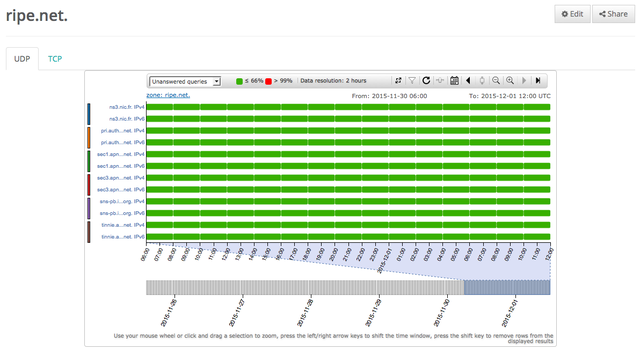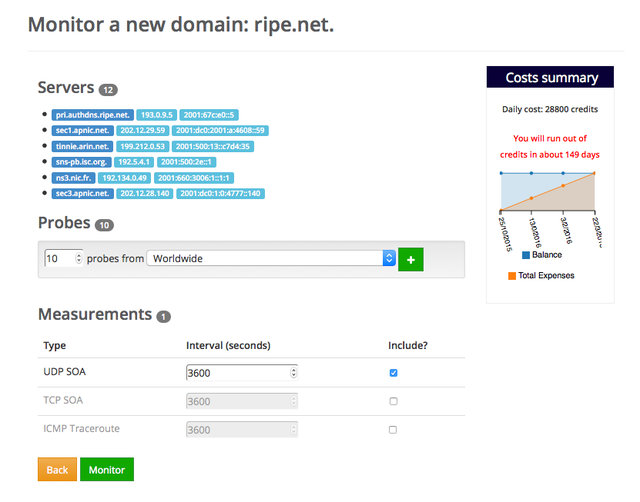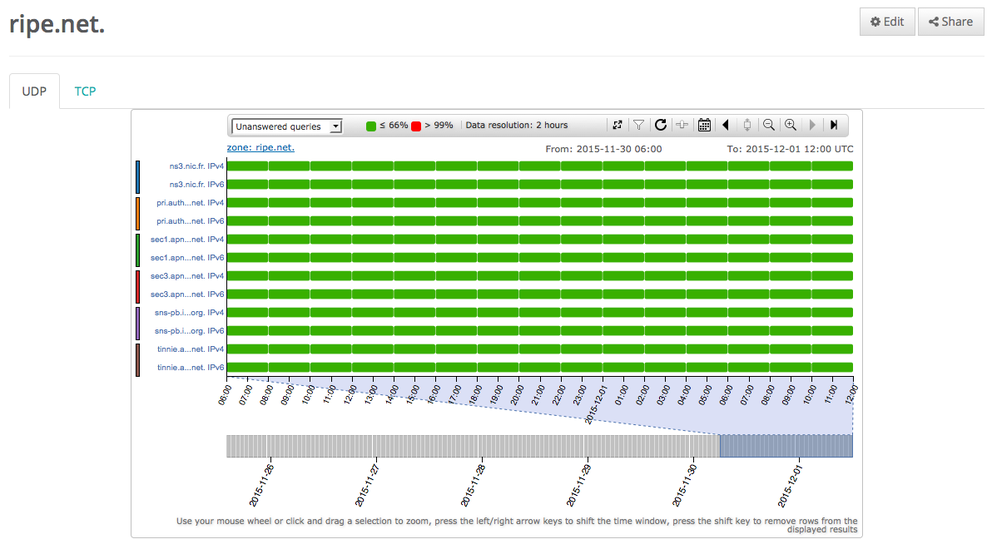A few weeks ago we gave you a heads up about a new visualisation tool in RIPE Atlas called DomainMON, and we're pleased to announce that this is now available for all RIPE Atlas users with available credits.
What it is
For some time now, RIPE Atlas users have been asking us for a tool to let them monitor their own domains (or any domain of their choosing), similar to what DNSMON does for high-level domain name servers. This feature has been available for several weeks to the RIPE Atlas testers group and we're happy to announce that it's now publicly available to all RIPE Atlas users.
DomainMON is powered by the same technology as DNSMON , which monitors various important DNS root and TLD name servers. DomainMON is like a "personal" version of DNSMON that can be used to monitor your own name servers - or any others of your choosing. It visualises the results in the same matrix view as DNSMON, giving you a quick overview of the quality of service offered by your name servers. You use your own RIPE Atlas credits to make the measurements, so you generally need to host or sponsor a RIPE Atlas probe or anchor in order to take advantage of this new tool.*

DomainMON visualises results in a matrix that offers an easy overview of service
How to use it
You can set up measurements in DomainMON with a handy wizard, which will guide you through the process. Once you enter the domain you want to monitor (usually a DNS zone with a SOA record), the wizard will automatically detect and present a list of name servers that serve the domain; however, you can also manually select the servers you're interested in. For example, maybe you're interested in how servers in one particular country serve your domain, in which case you could choose to use servers located only in that country.
If the domain you've entered is already being monitored by DNSMON, you'll get a notification to that effect.

Unlike with DNSMON (which uses RIPE Atlas anchors to perform measurements), DomainMON uses individual probes for its measurements. You can select between one and 50 probes (the maximum limit is to prevent over consumption of credits and overloading the visualisation). You can set the measurement type and frequency, and you'll get a handy graph showing how many credits your measurements will consume each day.
Once you've set up your measurements, you can see them visualised by clicking on the "visualise" button at the top of the page. You'll see the same matrix overview as with DNSMON.

The control panel is the same as with DNSMON, too, giving you just as much control over the way the measurement results are displayed. You can set the thresholds for the different quality parameters (i.e. what is considered "good" (green), "intermediate" (yellow) and "poor" (red)) for percentage of unanswered queries and response time. You can also filter results by protocol, adjust the time range represented, and zoom in and out.
The results are near real-time (to within approximately five minutes) and give a snapshot of your domain or, if you click the "continually update results" button on the control panel at the top right of the matrix, you'll get a dynamically updated view.
We hope you'll find this new tool useful, and are interested in how you'll use it. Let us know if you find some interesting results or want to share you own use case on RIPE Labs.
For more information about DomainMON, please see the documentation .
Feedback
As always, we want to know what you think of this new tool, or anything else about RIPE Atlas you'd like to share your thoughts on. Here's how to get in touch:
-
Leave a comment about this specific article below
- Please subscribe to the RIPE Atlas mailing list for discussions with active users and RIPE Atlas developers: ripe-atlas [at] ripe [dot] net
- If you want to report a bug or problem: atlas [at] ripe [dot] net
______________________
* If you are a researcher and have an interesting reason for wanting to measure a particular domain that you think will benefit the rest of the Internet community, but you don't have any RIPE Atlas credits, let us know and we'll evaluate your case.





Comments 2
The comments section is closed for articles published more than a year ago. If you'd like to inform us of any issues, please contact us.
Sandoche BALAKRICHENAN •
Hi, I am the project manager of the zonemaster (zonemaster.net) dns validation tool (https://github.com/zonemaster/zonemaster/blob/master/README.md) This open source tool is developed by Afnic (the French registry) and IIS (the Swedish registry). This tool is used by RIPE to validate the reverse IP address in the RIPE database. IMHO, it is the best available tool for DNS zone validation (everything open (BSD-2 licence for source code and Creative Commons Attribution 4.0 International License for the documentation) and with extensive documentation of all its modules and test cases) and it used by many well known DNS registries and registrars. My question is - will it be possible to integrate Zonemaster source code to verify a domain 's zone from different vantage points from RIPE root anchors? If you have any feedback to provide, please contact me at sandoche.balakrichenan@afnic.fr
Robert Kisteleki •
It's not entirely clear if you want to add RIPE Atlas support to zonemaster (then you can simply call APIs and integrate results that come back) or the other way around (adding zonemaster code to anchors -- which is much harder to do due to differences in working models).